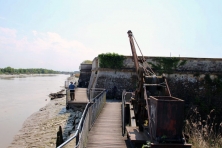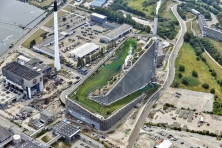Let the River In
Rochefort Océan (FR) - Winner
TEAM DATA
Team Representative: Lorenzo Alaimo (FR) – architect; Associate: Audrey Fourquet (FR) – architect
34 Rue de Cîteaux, 75012 Paris (FR)
+33 7 66 01 13 15 - alaimo_lorenzo@yahoo.fr
See the complete listing of portraits here
See the site page here

A. Fourquet & L. Alaimo
VIDEO (by the team)
INTERVIEW
1. How did you form the team for the competition?
We met during our economic studies in 2009, before continuing respective studies in architecture and urban planning. We pursued common interests for these two scales, with the same emphasis for economic processes. Our training was therefore complementary and we had different skills. The Europan competition and the chosen site scale was an opportunity for us to pool our skills and test our complementary professional personalities.
2. How do you define the main issue of your project, and how did you answer on this session main topic: the place of productive activities within the city?
The river is a starting point, the common element that makes it possible to rethink the place of productive activities and the link they maintain with each other. Whether by using the river in the city system or by accepting the risk, "Let the River In" proposes to reintroduce water into the city by its economic, social and environmental value. By developing principles of symbiotic economics, we laid the foundations for a process of urban and economic redefinition for the city of Rochefort. We rely on biological dynamics, in order to regenerate productive process, while strengthening existing economies and vocations. It is no longer a question to be opposed to nature or to break its balance, but to invent new activities with it, which use both the specificities of the territory and the local resources available to create a "new ways of doing things”. The river then becomes a major player to connect the city and the hinterland by rethinking the logic of transport or urban logistics. The project is also based on the river and its natural fluctuations, positioning itself between prevention and risk acceptance to reinvent the culture of water in Rochefort. The idea is to restore the river spaces through a set of proposals and thus activate the banks, in particular by implementing urban strategy and architectural solutions to protect against rising water and the risk of marine submersion that affects productive activities along the banks.
3. How did this issue and the questions raised by the site mutation meet?
The city of Rochefort considered four project sites, at first glance heterogeneous and autonomous. In a closed position with the city, these sites nevertheless occupied a strategic position along the Charente. Rather than treating each site in a separate logic and context, the junction and the relationship with the river was the main and founding argument to revive the sites and put them in synergy with one other. The project tries not to neglect any scale. It connects all of the sites and the stakeholders on the territory through the waste and resources they produce. Human activity, agriculture and the marine environment become linked in a new sustainable economy where the waste from these sectors is thought of both in its uses, its recovery and its return to the city.
4. Have you treated this issue previously? What were the reference projects that inspired yours?
One of us had already worked on the issue of waste management and urban bio-digesters in a previous study project. It is an experimental proposal at the scale of a city, but it allows us to explore new logics we believe in for the transformation of territories and economies. More broadly, the theme of the productive city and productive territories particularly interested us. Its scope and dimensions go beyond simple urban issues, which we appreciate. Questioning ourselves about the productive city also implied questioning the place of our world and local economies, the specificity of the territories and its future challenges.
5. Urban-architectural projects like the ones in Europan can only be implemented together with the actors through a negotiated process and in time. How did you consider this issue in your project?
Without necessarily proposing phasing, we have rather focused on levers of action. Whether in territories resilience in front of risks or economy changes, territorial actors need a toolbox and concrete solutions which can be activated either by public or private initiative. To bet on a sustainable process, we worked around the actors’ implication –each actor of the territory has an economic interest to enter into a new game of actors because it takes benefit of it–, on education –by reinforcing training courses in sustainable economy–, and on innovation –by creating a real knowledge base for the territory through an eco-campus. Activated together, these solutions feed a weaving of players in the region that trigger lasting changes in the chain.
6. Is it the first time you have been awarded a prize at Europan? How could this help you in your professional career?
Even if we have been wandering around there for several years, it is the first time we have participated to Europan. In addition to the resonance that such an award can have for our future, Europan represented above all a moment of personal growth, creative freedom and the concretization of ideas. This award encourages us to continue our reflections on the productive city.
TEAM IDENTITY
Office: LEN01
Functions: Architecture, Urbanism
Average age of the associates: 31 years old
Has your team, together or separately, already conceived or implemented some projects and/or won any competition? If yes, which ones?
No.

